Serviços Personalizados
Journal
Artigo
Indicadores
-
 Citado por SciELO
Citado por SciELO -
 Acessos
Acessos
Links relacionados
-
 Similares em
SciELO
Similares em
SciELO
Compartilhar
Economia Global e Gestão
versão impressa ISSN 0873-7444
Economia Global e Gestão v.14 n.1 Lisboa abr. 2009
Country of origin bias and firms international procurement: a case study on the rice sector in Portugal
Luca Panzone*, Miguel Malta**, Orlando Simões*** e Lucia Baldi****
ABSTRACT: Risiculture is a historical sector in Portuguese rural life and Portugal is the leading consumer of rice consumption in the European Union. The last 30 years have seen a steady decline in the internal production of rice alongside a greater concentration of milling operations. However, the production of milled rice has increased. Moreover, the introduction of Indica varieties in local risicultural systems and distribution channels has caused a dramatic change in consumption habits.
Through qualitative interviews with firms, this study analyzes what has driven entrepreneurs in the rice sector to choose the origin of their raw material; the presence of a country of origin bias is explained together with its consequences, namely in terms of the links between rice growers and rice millers. The study also analyzes the possibility of protecting local risiculture through a geographical indication of origin and it provides useful insights into the realities of the Portuguese rice sector for future research.
Key words: Rice Sector, Portugal, One-To-One Interviews, Trade
TÍTULO: Country of origin bias e escolhas das empresas: um caso de estudo no sector do arroz em Portugal
RESUMO: A risicultura é um sector histórico da vida rural em Portugal, sendo este o país com o consumo mais alto de arroz da comunidade europeia. Nos últimos 30 anos, a produção interna de arroz desceu consistentemente, com uma concentração das empresas de branqueamento. Ao mesmo tempo, a produção de arroz branqueado cresceu e a introdução de variedades Indica na risicultura local e na distribuição retalhista causou uma mudança dos consumos.
Através de entrevistas qualitativas, este estudo conduz a uma análise das motivações que guiam os empresários do sector do arroz na escolha da origem do arroz Paddy, detectando a presença de um country of origin bias, e as consequências que isso causou, nomeadamente em termos das relações entre as empresas branqueadoras e os agricultores. Este estudo analisa igualmente a possibilidade de proteger a risicultura nacional através da indicação geográfica e dá uma visão global da realidade do sector do arroz em Portugal.
Palavras-chave: Arroz, Portugal, Entrevistas Pessoais, Comércio Internacional
Country of origin (COO) bias is a common feature in many economic realities. In this research, a case study has been conducted analyzing the presence of COO bias in Portugal in a sector where the national supply of a raw material, rice in this particular case, is largely insufficient to satisfy national consumption. Using qualitative techniques, we explore how producers deal with the great disparity between the demand and supply of rice in Portugal, and the causes and consequences of firms choices in procurement.
Risiculture is a historical sector in Portuguese rural life. Protected continuously throughout history, rice has become the main product in Portuguese eating habits so that Portugal is the leading country for rice consumption in the European Union. Given the high rice demand (17.71 kg per capita in 2002), internal supply of rice has changed radically since Portugals entry into the European Union (EU), passing from autarky to a completely open customs union. A steady reduction of land harvested (-20% from 1975 to 2006) together with the introduction of Indica varieties in local risicultural systems and distribution channels have led to a dramatic change in the percentage of varieties consumed.
As a result, there has been a concentration in the industrial sector leading to an estimated loss of around 60% of industrial units since 19702. Procurement strategies for a country that had the highest cost of raw materials became crucial for industrial development after joining the EU in 1986. The first aim of this study was to understand the COO bias in the choice of procurement of Portuguese rice millers in 2003, trying to explore its relation with firms survival. However, the analysis also shed light on the relation between agriculture and food processing in the Portuguese rice sector, where international procurement was seen as a threat to local rice districts which some manufacturers felt the need to protect.
The paper is divided as follows. The first part provides an overview of the Portuguese rice sector. This is followed by a short review on COO bias. The third section presents the results of a qualitative survey of those firms milling rice in 2003. The paper closes with concluding remarks.
PORTUGUESE RICE SECTOR: AN OVERVIEW
Historically, the birth of risiculture in Portugal seems to date back to the Arabic invasion (8th century A.D. – Medina, 1995). Rice growing was abandoned after the countrys liberation (13th century A.D.) and then restored over the various ages, the last of which was in the 18th century (MADRP, 2002). Thereafter, rice consumption grew consistently and became embedded in Portuguese agriculture with a strong increase in consumption in the aftermath of World War I (Lains, 2003). Land dedicated to rice cultivation increased accordingly (Figure 1). A strong protectionist regulatory stance for cereals started in 1929 known as the Wheat Campaign under the dictatorial regime of Salazar (1926-1974). The campaign occurred through the development of autarkic ideals after serious concerns were raised on the sufficiency of this cereal (MADRP, 2002), supporting the growing power of "cereal lobbies" (principally rice and wheat – MADRP, 2002). Meanwhile, wetland areas were reclaimed and this arable land was relatively unproductive, rice was one of the crops chosen to be planted (MADRP, 2002). In 1972 the total amount of land harvested for rice reached its maximum at 43,487 Ha, showing the great success of Salazars protectionist policies (Vianna e Silva, 1975).
In 1933, a Commission board for rice was founded (CRCA – Regulating Commission of Rice Commerce) by big landowners in order to control market prices, regulate import and export and buy excess quantities of paddy. Many firms also established corporations (GIDA = Corporations of Rice Milling Industrialists) to give power to smaller millers and cooperating directly and closely with the board. These groups kept working until the end of the dictatorial regime in 1976, when they became part of an association of agricultural/industrial producers with no direct influence on market mechanisms or politics (MADRP, 2002).
Figure 1
Area harvested with rice in Portugal in the period 1918-1972
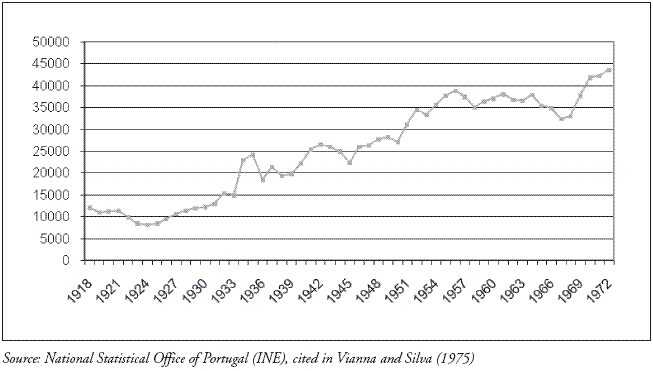
In more recent times, the entry of Portugal into the former EEC in 1986 stimulated the increase of arable land cultivated with rice (Figure 2), but the area of land cultivated decreased to 25.000 Ha in the early 1990s due to a 3-year drought period. The first reform in 1995 (COUNCIL REGULATION (CE) 3072/1995) provided further stimulus to grow rice, as production-dependent subsidies were seen as an incentive for greater improvement in yields that led to an unexpected increase in rice production (Commission of the European Communities, 2002). The following 2003 reform aimed at decoupling the subsidies, linking them only to production, while giving more availability to subsidies focused on rural development. However, while the outcome of this did not influence the objectives of our study as it was being approved during the interview period, the expectations about its content might have.
In terms of demand, Portugal has the highest level of individual consumption of rice in Europe. In 2002, supply was 17.7 kg per capita of milled equivalent3, corresponding to more than three times the EU average (5.1 kg)4 . Despite the relatively high internal demand, local agricultural production still remains limited, concentrated in three main areas of (Figure 3):
- Baixo Mondego and Baixo Vouga (with 26% of the area in 2000);
- Tagus and Sorraia Valleys (37% of the total area);
- Sado Valley (37% of the total area).
These three regions are located alongside rivers and with the exception of the River Tagus they flow completely within the national territory.
Firms have also been set up in the same areas, originally as small structures used mainly for milling rice, even for self-consumption. The increase in competition in the rice market forced the commercial development of rice mills and led to an intense concentration process that reduced the 60 (possibly more) existing companies in 1970 to around 18 in 2003.
Internal production in 2002/2003 potentially met around 70% of local demand (ENR, 2003). However, whilst rice production in Portugal is oriented almost entirely to Japonica varieties, consumption is around 60% Japonica and 40% Indica (ANIA, 2006), but is slowly approaching a 50%-50% level.
Figure 2
Area harvested with rice in Portugal in the period 1990-2006 compared to 1975
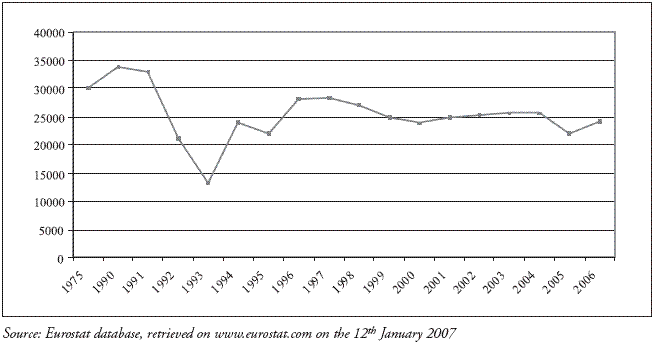
Figure 3
Location of Portuguese risicultural districts
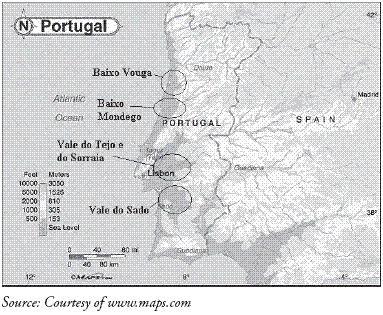
COO BIAS AND INTERNATIONAL PROCUREMENT
COO bias is a common feature of economic systems. It arises when products coming from different countries are perceived as different, albeit substantially very close substitutes. As a result, the origin of the product has a direct influence on the decision making process of consumers and producers, affecting their utility. This is commonly and more easily seen in demand studies, where the origin of brands and products evoke different sensations and stimulate different reactions (Haubl, 1996), i.e. in the wine sector this effect occurs where higher premiums are given to wines coming from specific countries (Steiner, 2004; Schamel, 2006). However, the supply side also shows the same discrimination (Quester et al., 2000), manifested in sourcing raw materials (Dzever and Quester, 1999), services (Pecotich et al., 1996) or human resources (Ferner, 1997) from different countries, with economic and socio-psychological reasons playing an important role (Verlegh, 2007).
The importance of the COO bias is more relevant in the context of an open economy where barriers to trade tend to be lower. In this case, procurement strategies tend toward a diversification of patterns since companies have to decide whether to import, and if so, what level of processing (raw, semi-processed or processed goods), and how much, opting for the most appropriate geographic origin of import according to their strategic objectives (Quintens et al., 2006; Quester et al., 2000).
COO effects have been observed in the agricultural and food sector (Skaggs et al., 1996) but mostly concern the demand implication they have generated. These concerns have been caused by consumers in developing countries that more frequently search for safe, environmentally sound and animal-health friendly goods and seem to have challenged the institutional tendency of favoring international trade. In fact, preservation of rural areas (Pinto-Correia, 2000, Marsden, 1999), food miles (Blanke and Burdick, 2005), compliance to animal welfare standards (Harper and Makatouni, 2002; Bennett, 1997), and compliance to food safety standards (Miles and Frewer, 2001) have become important for consumers and their influence has not gone unnoticed by manufacturers.
While COO effects became an extremely important tool for some companies profitability, in some developed countries COO effects on the search for quality food gave a competitive advantage to smaller producers in areas with a good reputation in producing food (Chevassus-Lozza and Galliano, 2003; OReilly and Haines, 2004; Bertolini and Giovannetti, 2006). In fact, in countries with a long agricultural tradition, sourcing products locally allowed existing links between agricultural history and industrial development in the food sector to be strengthened (Tregear, 2003) and the institutionalization of areas characterized by the uniqueness of their output (Casati et al., 1999; de Roest and Menghi, 2000).
This theoretical framework is now used to analyze COO bias in a country that has faced a considerable increase in trade liberalization over the last 22 years, first after joining the EU in 1986, but which subsequently enlarged after more countries joined in 1994, 2004 and 2008. Moreover, the adoption of international common agreements, namely the Everything but Arms, for the import of agricultural goods made Portugal increasingly exposed to international markets. The interest in the rice sector over all economic sectors is due to the real need to complete internal needs with imports, as introduced in the previous section, where procurement strategies of firms have become increasingly diversified.
THE SURVEY
In order to gain an insight into this sector, one-on-one interviews were conducted with the person responsible or jointly responsible for the procurement of raw materials. To this end, 18 firms were identified using various sources of information (ANIA – National Association of Rice Millers, internet, yellow pages, and existing publications). Of these, 16 firms were contacted and invited to participate, while two very small mills were excluded due to missing contacts. Of the companies contacted, two refused to participate, one was excluded for having no history (it was starting up), and another was excluded because of a large number of evasive answers. The remaining 12, accounting for an estimate of at least 80-85% of the market share both in value and in volume, completed a semi-structured questionnaire in the presence of the interviewer on their strategic choices. Interviews were performed between March and May 2003. Some multiple choice questions, essential to classify firms, were also integrated into different sections of the questionnaire.
RESULTS
Description of the Sample
The characteristics of the sample of firms interviewed are reported in Table 1. The rice milling sector is relatively fragmented, where the top 3 firms in the sector in 2002 accounted for 40% of the market (AC Nielsen, 2002), and the remaining 60% is shared among several small, occasionally family-run firms whose market share is rarely over 5%. Of the 12 firms interviewed, only 8 import rice, with imports representing different percentages of their total production. It is interesting to note that non-importers generally share less than 10% of the market, while those firms importing more than 25% of their production share more than 10% of the market (Figure 4a).
In terms of products sold, all the 12 firms market the two basic segments: Agulha (Indica varieties, almost entirely imported) and Carolino (mixture of Japonica varieties). Other segments are represented by easy-cook rice, parboiled rice, wholemeal and fragrant rice. However, product differentiation is greater for bigger firms while smaller firms tend to market only the two main products (Carolino and Agulha) (Figure 4b). Some small millers occasionally market a third segment, and it is those firms who seem to maintain a certain competitiveness. An interesting and surprising factor is that those companies producing higher percentages of the local variety, the Carolino, generally share smaller portions of the market, whereas the increase in sale of foreign varieties, the Agulha, corresponds to higher market shares (Figures 4c and 4d).
Table 1
General characteristics of the sample
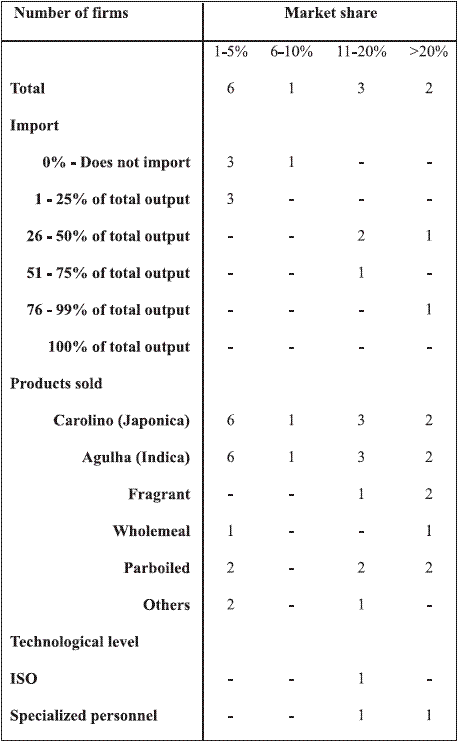
Figure 4
Relation between market share and market characteristics of the sample
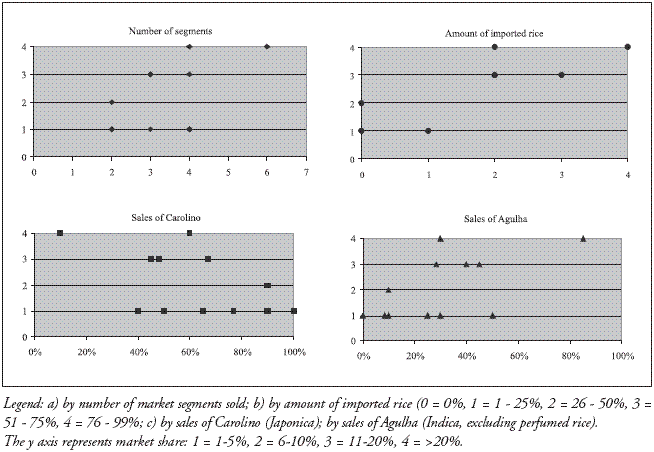
Other firms had a very low technical level and face difficulties to adapt to sudden changes in supply. In fact, in terms of hygiene and quality control, only two firms had specialized personnel (food engineers), and one of these was also ISO certified. Moreover, Portuguese firms at the time could only produce white and wholemeal rice, and only one company had facilities to produce parboiled rice. In case of short-run changes in demand, only seven mills were able to adapt both quantitatively (producing more) and qualitatively (supplying different varieties). On the other hand, one (small family-run) firm was completely unable to change its production pattern, while another four companies could only increase the quantity sold.
COO Bias in Procurement of the Portuguese Rice Sector
Portuguese rice millers tend to source raw rice from two main areas (Table 2): the European Union, and the Guyanas in South America. In general, the main justification companies provide in their choice of procurement is the need to compensate national disparity between demand and supply with high quality product.
European procurement is represented primarily by Spain; 7 of Spains 8 importers supply both Japonica and Indica grains (the latter as a Thaibonnet variety), plus parboiled and pre-cooked rice. This is justified by a location advantage, which implies low transport cost, and cultural proximity, while supplying high quality raw materials. Less frequent is the choice of procurement from Italy, chosen for its higher technological level in producing parboiled rice, and France, which has the advantage of proximity due to communities of migrants; relative vicinity is important for both countries in driving firms choice. Greece is also chosen for its overall technological level, which allows sourcing parboiled rice with excellent value for money.
Companies justify the choice of sourcing rice from Guyana (former British Guyana) and Suriname (former Dutch Guyana) as being demand-led, since they supply Indica varieties of extraordinary qualities, much in demand by consumers and with characteristics that cannot be replicated in Portugal. However, Guyana and Suriname receive preferential treatment for rice supply as they are included in the Everything but Arms (EBA) agreement, while possessing strong historical links and present commercial ties with other European countries.
Table 2
Origin of imports
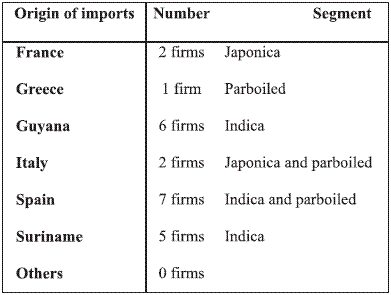
Strangely, an essential variable in procurement such as price is only mentioned directly by one interviewee, although strategies focusing on vicinity (meaning decreasing transport costs), quality and different products (price premium), and value for money are clear indications of price-based competition strategies. Importantly, international procurement in rice procurement is generally an indirect transaction where companies do not meet their suppliers directly. In the case of the Portuguese rice sector, this is done through brokers (the most common), growers representative (including farmers cooperatives), or other millers who are either independent or managed by the same holding as the importer (for processed or semi-processed rice). However, despite the relative transaction costs, importers still find it more convenient to import than to source locally or nationally.
While international procurement accounts for 46.7% of the internal needs, 55.3% of the internal consumption of rice in the 2002/2003 was satisfied by the internal production, with as much as 85.3% for Japonica varieties and a modest 12.7% of Indica varieties. As a result, national procurement remains an important source for Portuguese mills and is essential for those companies that opted not to import raw materials. These non-importers in Portugal are either very small companies owning rice harvested land, for whom the economic commitment of importing is too high, or cooperatives whose constitutional strategy is to give added value to local produce. In both cases, the decision not to source raw materials internationally derives from the need to value own production, which reduces costs of production and increases the added value of the agricultural produce. Contrary to what is highlighted by importers, these companies claim the superiority of Portuguese rice in terms of quality, making importing unessential and fashionable (word used by one interviewee) and from their point of view creating unfair competition. In fact, despite recognizing that the economic disadvantage of their national policy increases financial pressure, these firms do not find any substantial disadvantage in not importing because they avoid the use of external capitals in a phase where the market is not remunerative.
The Causes and the Consequences of the COO Bias
The choice taken by Portuguese firms to source raw materials internationally is clearly justified by the very high price of the internal production. In fact, historically prices have been higher in Portugal than other EU producers (Figure 5), and the competitiveness of the environment directed rice mills toward cheaper raw material. The search for cheaper prices came in a period when 11 of the 12 respondents acknowledged that the sector had deteriorated in recent times due to what managers defined as unfair competition in the market. The extreme price competition in the market is considered the first cause generating unfairness and the most serious problem. The reasons indicated by managers for this are the extreme price policy of big retailer chains as the cause for a price-based competition, and the entrance of multinational enterprises in a very fragmented market. These two events reportedly created a decrease in price and liquidity that, according to two different respondents, led to a decline in quality and the impossibility to comply with basic hygiene regulations. However, the investments of foreign companies in the Portuguese rice sector have allowed the productive processes to become more efficient, although respondents tend to stress that the sector has never been restructured, namely from a technological point of view.
Figure 5
Selling prices of rice (absolute prices) in the EU– annual (Euro (from 1.1.1999)/ECU (up to 31.12.1998)
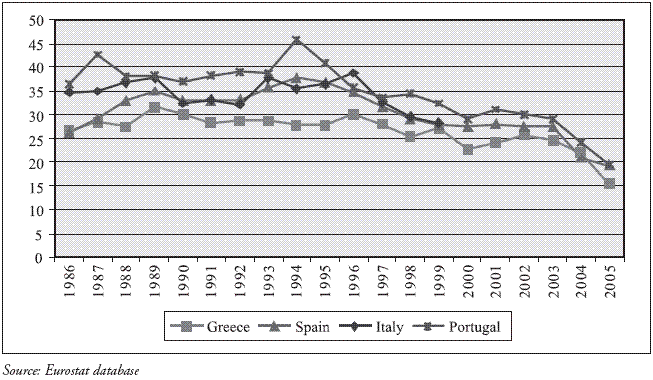
In contrast, this COO bias of rice millers which clearly favors external over national raw materials is not found on the demand side. From informal conversations with consumers, and as highlighted in MADRP/GPPAA (1999), there seems to be a clear COO bias in demand favoring internal production, consistent with earlier studies that found nationalist bias in consumers valuations in developed countries (i.e. Bannister and Saunders, 1978; Arnoult et al., 2007). However, though no research has effectively tried either to investigate the presence of the bias or measure it, this finding would suggest the existence of a completely different quality perception of demand and supply, which is symptomatic of adverse selection. The fact that all the rice is actually marketed without specifying the origin of the raw material (most of the milling is done in Portugal) complicates the situation because consumers cannot make an informed choice when buying.
As a consequence, the existence of firms COO bias caused some of the companies to lobby for the establishment of a new market segment with a denomination of origin to be given to Carolino rice. This policy would certify the national origin of the product along with the processing taken in one of the main rice growing areas. This idea was strongly supported by non-importers but challenged by large importers who claimed it would give a temporary unfair advantage to those small firms that base their sale only on national rice. However, one of the respondents correctly noted that a Carolino DOP denomination could not be obtained at present because all seeds used by growers actually come from outside the country. Nonetheless, 8 of the 12 companies interviewed recognized the creation of a denomination of origin as an important step because it would give the advantage of a product with a higher value added, whilst stimulating the protection of national agriculture. An additional advantage of a denomination of origin recognized by the interviewees is its importance in protecting consumers and improving the quality of the process from the beginning of the food chain.
A fear shared by many interviewees regarding the presence of this COO bias was the increase in the distance between agriculture and food production. In fact, most of the managers mentioned they knew a large percentage or even all of their national suppliers personally, and in some case said they had cooperated actively in their development. Confronted with the prospect of a progressive decrease in trade barriers for rice coming from outside the EU, and presented in the 2003 Common Agricultural Policy, the market seemed to show different perspectives. Pessimists forecasted an increase in uncertainties for local agriculture which would impact national production negatively, while optimists hoped for a possible increase in export due to greater competitiveness worldwide and fairer domestic competition.
CONCLUSIONS
The present study analyzes the existence and impact of COO bias in the Portuguese rice sector. Risiculture merges with history and tradition here in a social agricultural context and rice is an essential commodity even though the industrial sector underwent a long period of economic instability. In face of competition based largely on price, rice mills were able to survive by identifying suppliers of raw material from countries outside the national borders that would allow them to remain competitive in the market. Although this COO bias has proved extremely important for the survival of the sector, it decreased profitability for the agricultural side of the market where the price of Japonica varieties declined steadily. This choice of sourcing raw materials internationally led to the fear of weakening the strong link between local agriculture and the industrial sector as many local producers are being discouraged from growing rice, threatening the future of a strong food culture in Portugal.
This increasing awareness of risiculture has triggered new ideas. The creation of rice districts in the four producing areas, protected through a geographical indication is a possible solution that can stimulate local production while guaranteeing improvements in the food-chain. This option, which could successfully protect traditions and local agriculture (Casati, Banterle and Baldi, 1999), has proved to be viable for other rice producing countries (i.e., riz de Camargue in France; Riso di Baraggia Biellese e Vercellese and Riso Nano Vialone Veronese in Italy; Arroz del Delta del Ebro and Arroz de Valencia in Spain are all DOP5); it could also work in Portugal and increase added value for both farmers and millers.
However, this research needs be followed up by further studies in the sector focused on understanding the potentials of risiculture in Portugal. From a marketing point of view, it is essential to understand consumers perception of national rice and try to understand whether there is also a COO bias in demand, and how it is structured. The perception of risiculture from an environmental viewpoint also plays an important role since it can shed light on the importance of preserving risiculture not only for economic or commercial purposes, but also as an environmental asset for the population.
Acknowledgements
This work was prepared in a joint project between the University of Milan, the Agricultural College of Coimbra and Luca Panzone in the University of Milan. We would like to thank Dr. Pedro Monteiro of the National Association of Rice Millers (ANIA) for his help during the fieldwork. We would also like to thank Viviana Albani, Francisco Areal and Suthep Nimsai for comments on earlier versions of this work. We are indebted to Pinar Cabadag for her important support in the editing of this paper. The remaining errors are solely the authors responsibility.
NOTES
1 - FAO Database, http://faostat.fao.org/faostat/collections?subset=agriculture, retrieved on the 12th January 2007.
2 - ANIA
3 - FAO Database, http://faostat.fao.org/faostat/collections?subset=agriculture, retrieved on the 12th January 2007.
4 - Ibidem.
5 - http://ec.europa.eu/agriculture/qual/it/pgi_04it.htm.
REFERENCES
NIELSEN, A. C. (2003), ANUÁRIO 2002. Ed. Ac Nielsen Portugal.
ANIA (2006), «Balanço 1997/2006». www.ania.pt.
ARNOULT, M.; LOBB, A. & TIFFIN, R. (2007), «The UK consumers attitudes to, and willingness to pay for, imported foods». Contributed Paper prepared for presentation at the 105th EAAE Seminar: International Marketing & International Trade of Quality Food Products, Bologna, Italy, March 8-10.
BANNISTER, J. P. & SAUNDERS, J. A. (1978), «UK consumers attitude toward imports: the measurement of national stereotype image». European Journal of Marketing, vol. 12(78), pp. 562-570. [ Links ]
BENNETT, R. M. (1997), «Farm animal welfare and food policy». Food Policy, vol. 22(4), pp. 281-288.
BERTOLINI, P. & GIOVANNETTI, E. (2006), «Industrial districts and internationalization: the case of the agri-food industry in Modena, Italy». Entrepreneurship & Regional Development, vol. 18, pp. 279-304.
BILKEY, W. J & NES, E. (1982), «Country-of-Origin effects on product evaluations». Journal of International Business Studies, vol. 13, pp. 89–100.
BLANKE, M. M. & BURDICK, B. (2005), «Food (miles) for thought. Energy balance for locally-grown versus imported apple fruit». Environmental Science and Pollution Research, vol. 12(3), pp. 125-127.
CASATI, D.; BANTERLE, A. & BALDI L. (1999), Il Distretto Agro-Industriale Del Riso. Franco Angeli, Milan.
CHEVASSUS-LOZZA, E. & GALLIANO, D. (2003), «Local spillovers, firm organization and export behaviour: evidence from the french food industry». Regional Studies, vol. 37, pp. 147-158.
COMMISSION OF THE EUROPEAN COMMUNITIES (2002), «The Agricultural Situation in the European Union. Report 2000». Report in conjunction with the General Report on the Activities of the European Union. http://eur-lex.europa.eu/LexUriServ/LexUriServ.do?uri=COM:2002:0067:FIN:EN:PDF.
DE ROEST, K. & MENGHI, A. (2000), «Reconsidering 'traditional' food: the case of Parmigiano Reggiano cheese». Sociologia Ruralis, vol. 40, pp. 439–451.
DZEVER, S. & QUESTER, P. (1999), «Country-Of-Origin effects on purchasing agents' product perceptions: an australian perspective». Industrial Marketing Management, vol. 28(2), pp. 165-175.
ENTE NAZIONALE RISI (ENR) (2003), «Data on production and areas – Internal documents». In EU Council (1995), Common Organization of the Market in Rice, Council Regulation (EC) 3072/1995.
FERNER, A. (1997), «Country of origin effects and HRM in multinational companies». Human Resource Management Journal, vol. 7(1), pp. 19-37.
HARPER, G. C. & MAKATOUNI, A. (2002), «Consumer perception of organic food production and farm animal welfare». British Food Journal, vol. 104 (3/4/5), pp. 287-299.
HAUBL, G. (1996), «A cross-national investigation of the effects of country of origin and brand name on the evaluation of a new car». International Marketing Review, vol. 13(5), pp. 76-97.
INGA (2003), O Sector do Arroz na UE e em Portugal: Principais Aspectos e Actuais Perspectivas.
LAINS, P. (2003), «Portugals growth paradox, 1870-1950». Universidade do Porto, Faculdade de Economia do Porto, Working Paper no. 135.
MINISTÉRIO DA AGRICULTURA, DO DESENVOLVIMENTO RURAL E DAS PESCAS (MADRP) (2002), Cereais em Portugal no Século XX (Instrumentos de Pesquisa para a História dos Organismos Responsáveis pela Política Cerealífera em Portugal no Século XX). Lisboa.
MINISTÉRIO DA AGRICULTURA, DO DESENVOLVIMENTO RURAL E DAS PESCAS (MADRP)/GPPAA (1999), Estudo de Marketing do Sector do Arroz – Relatório da Fase A: Análise do Mercado. Ed. Tecninvest.
MINISTÉRIO DA AGRICULTURA, DO DESENVOLVIMENTO RURAL E DAS PESCAS (MADRP)/GPPAA (2000), Estudo de Marketing do Sector do Arroz – Relatório da Fase B: Estratégia de Marketing. Ed. Tecninvest.
MARSDEN, T. (1999), «Rural Futures: The Consumption Countryside and its Regulation». Sociologia Ruralis, vol. 39(4), pp. 501-526.
MEDINA, J. (1995), História de Portugal – Dos Tempos Pré-Históricos aos Nossos Dias. Ed. Clube Internacional do Livro, Lisboa.
MILES, S. & FREWER, L. J. (2001), «Investigating specific concerns about different food hazards». Food Quality and Preference, vol. 12(1), pp. 47-61.
O'REILLY, S. & HAINES, M. (2004), «Marketing quality food products – A comparison of two SME marketing networks». Acta Agriculturae Scandinavica, Section C – Economy, no. 1, pp. 137-150.
PECOTICH, A.; PRESSLEY, M. & ROTH, D. (1996), «The impact of country of origin in the retail service context». Journal of Retailing and Consumer Services, vol. 3(4), pp. 213-224.
PINTO-CORREIA, T. (2000), «Future development in Portuguese rural areas: how to manage agricultural support for landscape conservation?». Landscape and Urban Planning, vol. 50(1-3), pp. 95-106.
QUESTER, P. G.; DZEVER, S. & CHETTY S. (2000), «Country-of-origin effects on purchasing agents product perceptions: an international perspective». Journal of Business and Industrial Marketing, vol. 15(7), pp. 479-490.
QUINTENS, L.; PAUWELS, P. & MATTHYSSENS, P. (2006), «Global purchasing: state of the art and research directions». Journal of Purchasing and Supply Management, vol. 12(4), pp. 170-181.
SCHAMEL, G. (2006), «Geography versus brands in a global wine market». Agribusiness, vol. 22(3), pp. 363-374.
SKAGGS, R.; FALK, C.; ALMONTE, J. & CARDENAS, M. (1996), «Product-country images and international food marketing: relationships and research needs». Agribusiness, vol. 12(6), pp. 593-600.
STEINER, B. (2004), «French wines on the decline? Econometric evidence from Britain». Journal of Agricultural Economics, vol. 55(2), pp. 267-288.
TREGEAR, A. (2003), «From Stilton to Vimto: using food history to re-think typical products in rural development». Sociologia Ruralis, vol. 43, pp. 91-107.
VERLEGH, P. W. J. (2007), «Home country bias in product evaluation: the complementary roles of economic and socio-psychological motives». Journal of International Business Studies, vol. 38(3), pp. 361-373.
VIANNA E SILVA, M. (1975), A Cultura do Arroz. Clássica Editora, Lisboa.
* Luca Panzone
l.a.panzone@reading.ac.uk
PhD candidate at Department of Agricultural and Food Economics, University of Reading, UK.
Aluno de Doutoramento do Departamento de Economia da Agricultura e Alimentar da Univer-sidade de Reading, Reino Unido.
** Miguel Mata
mmalta@mail.esac.pt
Professor in Rural Development at Higher School of Agriculture of Coimbra, Portugal.
Professor na Escola Superior Agrária de Coimbra, Portugal.
*** Orlando Simões
orlando@esac.pt
Professor in Rural Sociology at Higher School of Agriculture of Coimbra, Portugal.
Professor na Escola Superior Agrária de Coimbra, Portugal.
**** Lucia Baldi
lucia.baldi@unimi.pt
Professor in Agricultural Economics and Statistics at University of Milan, Italy.
Professora de Economia e Estatística da Agricultura na Universidade de Milão, Itália.













